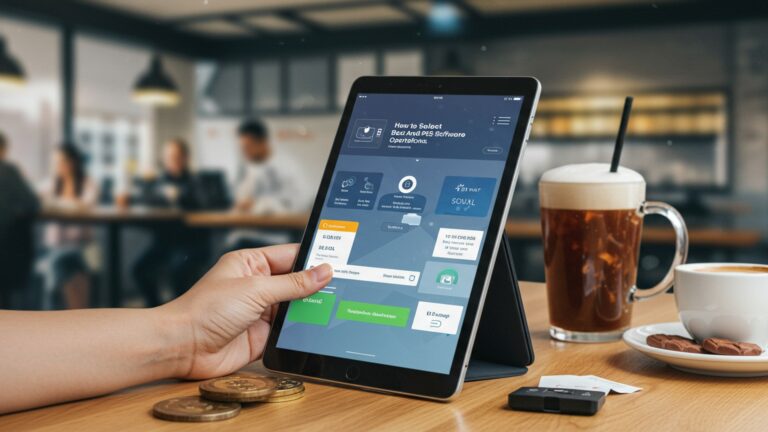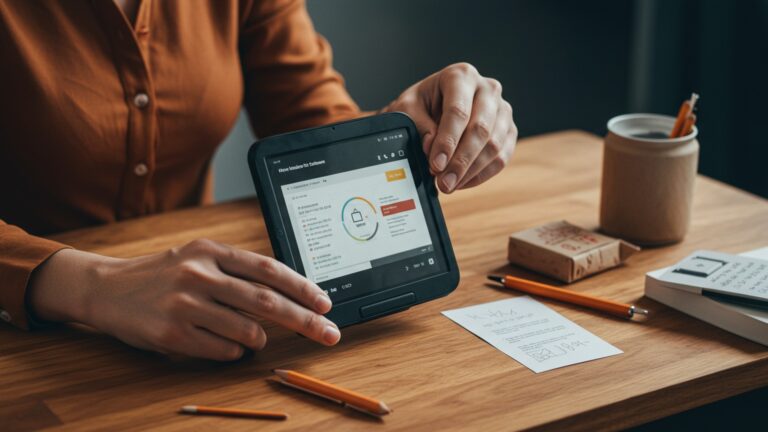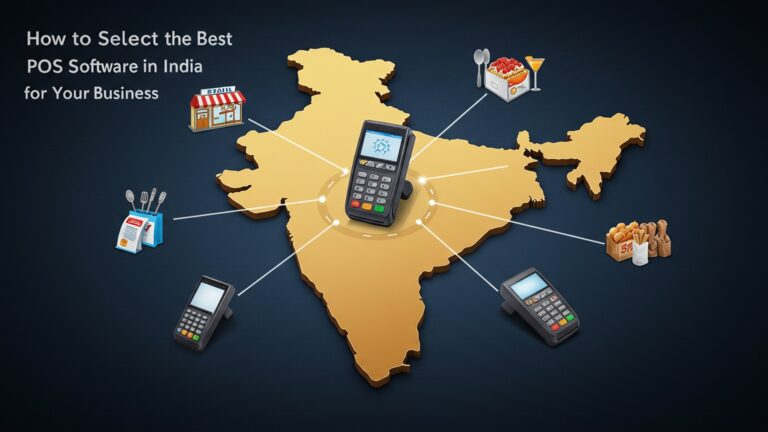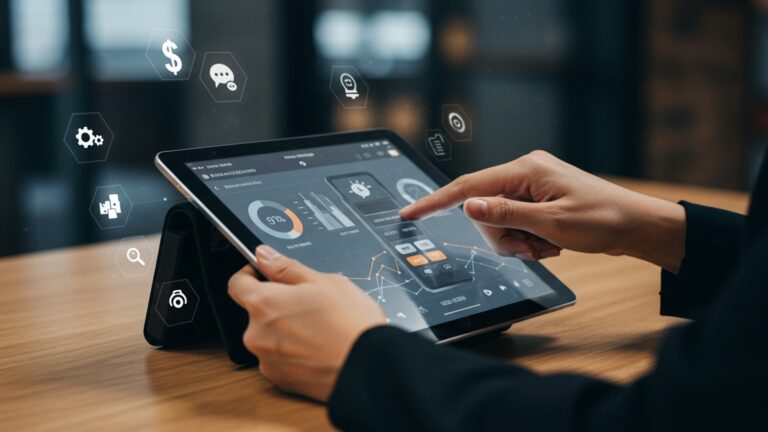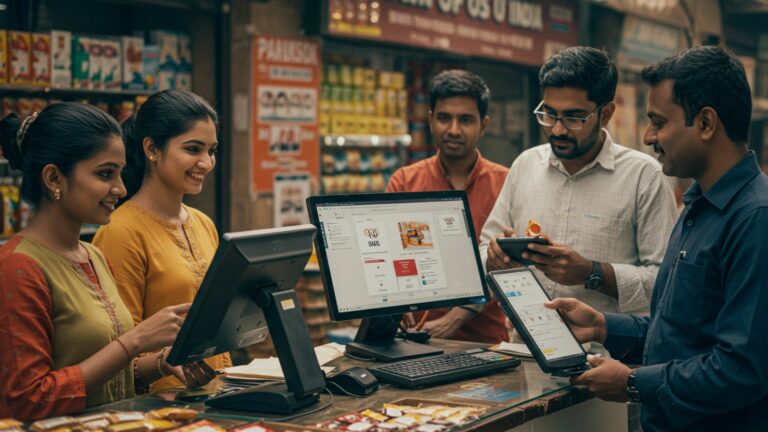Streamline Your Grocery Store How to Select POS Software for Inventory Management
Grocery store owners navigate a complex landscape, battling volatile inventory – from fresh produce with short shelf lives to thousands of packaged SKUs – alongside persistent supply chain disruptions and evolving consumer demands. A high-performing pos software for grocery store operations transcends mere transaction processing, becoming the crucial intelligence hub for precise inventory management. Advanced systems now integrate AI-driven demand forecasting to significantly reduce shrink and prevent costly stockouts, a vital capability for perishable goods and dynamic promotions. Choosing the optimal platform empowers businesses with real-time data on sales velocity and vendor performance, facilitating agile reordering and seamless integration with omnichannel services like click-and-collect, ultimately boosting profitability and customer satisfaction through optimized stock and streamlined workflows.
The Unseen Backbone: Why Grocery Inventory Management Matters More Than Ever
For any grocery store owner, the daily dance of fresh produce, rapidly moving staples. specialty items can feel like a high-stakes performance. Inventory management isn’t just about counting what’s on the shelves; it’s the beating heart of your store’s profitability, customer satisfaction. operational efficiency. Imagine the sheer volume of unique products, known as Stock Keeping Units (SKUs), that cycle through your aisles daily – from a single head of lettuce to a pallet of canned goods. Managing this manually, with clipboards and spreadsheets, is not only time-consuming but also prone to costly errors.
The complexities are numerous: perishables require strict sell-by dates, promotional items demand accurate forecasting. popular products need constant replenishment to avoid stockouts. Without a robust system, grocery stores face significant challenges:
- Shrinkage and Spoilage
- Stockouts and Overstocking
- Inefficient Ordering
- Lost Productivity
Mismanaged inventory leads to expired goods, damaged products. theft, directly eating into your profit margins.
Too little of a popular item means lost sales and frustrated customers. Too much means wasted capital, potential spoilage. reduced shelf space for other products.
Manual ordering is often based on guesswork rather than data, leading to either excess stock or insufficient supply.
Employees spend valuable time on manual inventory counts instead of serving customers or improving the shopping experience.
These challenges highlight a critical need for modern solutions that can keep pace with the dynamic environment of a grocery store. This is where technology steps in to transform a complex problem into a streamlined operation.
Unpacking POS Software: Your Grocery Store’s Smart Assistant
At its core, a Point of Sale (POS) system is the hardware and software that processes transactions when a customer makes a purchase. But, modern pos software for grocery store environments has evolved far beyond simple cash registers. Today, it’s a comprehensive management hub, intricately linking sales data with inventory, customer details. even employee performance. For a grocery store, the inventory management capabilities of POS software are particularly transformative.
Think of it as the central nervous system for your store. Every scan at the checkout, every return, every incoming shipment. every transfer between departments is recorded and analyzed by the POS system. This real-time data flow is what empowers grocery store owners to make informed decisions that were previously impossible without extensive manual effort.
Here’s how a sophisticated pos software for grocery store operations extends its reach beyond just ringing up sales:
- Automated Data Capture
- Centralized data
- Enhanced Customer Experience
- Strategic Decision Making
Every item sold instantly updates inventory counts, eliminating manual deductions and significantly improving accuracy.
All product data, including pricing, supplier details. stock levels, is stored in one accessible location.
Faster checkouts, accurate pricing. readily available products contribute to happier customers.
With granular data at your fingertips, you can identify best-selling items, slow-movers. seasonal trends, allowing for optimized purchasing and merchandising strategies.
In essence, the right POS software transforms your sales counter from a mere transaction point into a powerful data collection and management engine, especially crucial for navigating the high-volume, low-margin world of grocery retail.
Essential Inventory Management Features for Your Grocery POS
When selecting pos software for grocery store inventory management, certain features are non-negotiable. These functionalities are designed to tackle the unique challenges of grocery retail, ensuring efficiency and profitability.
- Real-Time Inventory Tracking
- Automated Ordering and Reordering
- Batch Tracking and Lot Management
- Multi-Location Inventory Management
- Wastage and Spoilage Tracking
- Supplier Management
- Barcode Scanning Integration
This is paramount. Every sale, return. receipt of goods is instantly reflected in your inventory counts. This means you always know exactly what you have in stock, preventing stockouts of popular items and reducing overstocking of slow-moving products. For instance, if a customer buys a particular brand of organic milk, the system immediately deducts it from the available count, providing an accurate, live snapshot of your dairy aisle.
Manual ordering is a guessing game. Top-tier POS software allows you to set reorder points for each product. When stock levels hit a predefined minimum, the system can automatically generate purchase orders, or at least flag items for reorder. Some advanced systems can even factor in sales trends, seasonality. lead times to suggest optimal order quantities, drastically reducing the risk of either running out or accumulating excess stock.
Crucial for perishables, this feature tracks products by specific batches or lots. This is invaluable for managing expiration dates, ensuring “first-in, first-out” (FIFO) practices, and, critically, for food safety recalls. If a specific lot of produce is recalled, you can quickly identify exactly which items from that lot were sold and which remain on your shelves.
If you operate more than one grocery store, this feature is essential. It allows you to view and manage inventory across all your locations from a single interface. You can track transfers between stores, consolidate ordering. balance stock levels to meet demand variations across different branches.
This specialized feature allows employees to easily log spoiled, damaged, or expired goods. By tracking these losses, the POS software provides data on which products contribute most to wastage, helping you identify issues with ordering, storage, or supplier quality. Understanding these patterns can lead to significant cost savings.
Keep all your vendor insights—contact details, pricing agreements, lead times. order history—organized within the POS. This streamlines the procurement process, making it easier to compare supplier performance and negotiate better terms.
While seemingly basic, seamless integration with barcode scanners at the POS and for inventory receiving is fundamental. It ensures accurate and rapid data entry for both sales and stock management, minimizing human error.
Beyond the Stockroom: Other Critical POS Features for Grocery Success
While inventory management is a primary driver for adopting advanced pos software for grocery store operations, a truly effective system offers a suite of functionalities that boost overall store performance, customer loyalty. employee efficiency. These features, though not directly inventory-focused, indirectly support a smoother, more profitable retail environment.
- Customer Relationship Management (CRM) & Loyalty Programs
- Employee Management
- Comprehensive Reporting and Analytics
- Integrated Payment Processing
- Scalability
- Security Features
- User-Friendly Interface
Modern POS systems integrate CRM capabilities, allowing you to track customer purchase history, preferences. contact data. This data powers loyalty programs, enabling you to offer personalized discounts, send targeted promotions. reward frequent shoppers. For example, if a customer regularly buys gluten-free products, the system can flag them for promotions on new gluten-free arrivals, fostering stronger relationships and repeat business.
Streamline staff operations with features like time clock functionality, shift scheduling. performance tracking. Assigning specific user roles and permissions ensures that employees only access the parts of the system relevant to their job, enhancing security and accountability.
Beyond basic inventory reports, a robust POS offers deep insights into sales trends by product, category, time of day. even employee. You can assess profit margins, identify peak shopping hours, interpret customer behavior. make data-driven decisions about staffing, promotions. product placement. This foresight is invaluable in a competitive market.
Seamlessly process various payment methods, including credit/debit cards, mobile payments (e. g. , Apple Pay, Google Pay). gift cards. Integrated processing means faster transactions, fewer errors. simplified end-of-day reconciliation.
Your POS system should be able to grow with your business. Whether you’re adding more checkout lanes, expanding product lines, or opening new locations, the software should accommodate increased demands without requiring a complete system overhaul.
Protect sensitive customer and business data with robust security measures, including data encryption, secure payment gateways. user access controls. Compliance with industry standards (e. g. , PCI DSS for payment processing) is crucial.
An intuitive and easy-to-learn interface reduces training time for new employees and minimizes operational errors. A system that’s simple to navigate ensures that all staff, from cashiers to store managers, can efficiently utilize its features.
Navigating the Options: Comparing POS Software for Your Grocery Store
Choosing the right pos software for grocery store inventory management can feel overwhelming given the array of options available. To make an informed decision, it’s crucial to compare systems based on key criteria that align with your specific business needs and future goals. Here’s a comparison framework to help you evaluate potential solutions:
| Feature/Consideration | Cloud-Based POS | On-Premise POS |
|---|---|---|
| Deployment & Accessibility | Software hosted on remote servers, accessible via internet browser from any device, anywhere. | Software installed directly on your store’s computers/servers. Access often limited to store network. |
| Cost Structure | Typically subscription-based (monthly/annually). Lower upfront hardware costs. | Higher upfront cost for software license and server hardware. Lower ongoing subscription fees (or none). |
| Maintenance & Updates | Managed by the vendor. Automatic updates, backups. security patches. | Your responsibility or requires IT staff/contractor. Manual updates and backups. |
| Scalability | Easily scalable; add users, locations, or features with a plan upgrade. | Scalability depends on server capacity and license terms; can be more complex to expand. |
| Data Security | Vendor responsible for security, often with robust enterprise-level measures. Requires reliable internet. | Your responsibility. Data is stored locally, potentially less susceptible to external online threats but vulnerable to local hardware failure. |
| Internet Dependency | Requires a stable internet connection for full functionality (though some offer offline modes). | Functions without internet. online features (e. g. , credit card processing) still need it. |
| Customization | Generally less customizable out-of-the-box due to multi-tenant architecture. often offers integrations. | Can be highly customized to specific workflows. this often comes at a higher development cost. |
Beyond deployment models, consider these crucial factors when evaluating any pos software for grocery store:
- Pricing Models
- Vendor Support
- Integration Capabilities
- Hardware Compatibility
- Reputation and Reviews
comprehend the total cost of ownership. Does it include hardware, installation, training. ongoing support? Be wary of hidden fees.
Does the vendor offer 24/7 support? What are their response times? Are there self-help resources, tutorials, or dedicated account managers? Reliable support is invaluable when issues arise during peak hours.
Can the POS integrate with other essential software you use, such as accounting platforms (e. g. , QuickBooks, Xero), e-commerce platforms (if you plan online ordering), or even dedicated deli scales? Seamless integration prevents data silos and manual data entry.
Will the software work with your existing hardware (scanners, receipt printers, cash drawers) or will you need to invest in new equipment? Ensure compatibility to avoid unexpected costs.
Research what other grocery store owners say about the software. Look for independent reviews and case studies to gauge real-world performance and customer satisfaction.
Real-World Impact: Transforming Operations at “Fresh & Fast Grocers”
Let’s consider the story of “Fresh & Fast Grocers,” a mid-sized independent grocery store facing significant challenges with inventory shrinkage and inefficient ordering. Before implementing a modern pos software for grocery store, owner David relied on manual counts and intuition to manage his vast array of products, from organic produce to imported cheeses. This led to frequent stockouts of popular items, excessive waste from expired goods. countless hours spent by staff on inventory reconciliation instead of engaging with customers.
David decided to invest in a cloud-based POS system that offered robust inventory management features. Here’s how it changed his business:
- Reduced Spoilage by 15%
- Optimized Ordering, Saving 10% on Purchasing Costs
- Increased Employee Productivity
- Improved Customer Satisfaction
With real-time inventory tracking and batch management, David could accurately monitor expiration dates for perishables. The system automatically flagged items nearing their sell-by date, allowing him to implement proactive discount strategies or use them in the deli section, significantly cutting down on waste.
The automated reordering feature, based on historical sales data and vendor lead times, eliminated guesswork. David’s purchasing manager could now generate precise purchase orders, reducing overstocking and ensuring popular items were always in stock, leading to fewer lost sales and better cash flow.
Staff previously spent an average of 15 hours per week on manual inventory tasks. With the new POS, this was reduced to just 3-4 hours, freeing up employees to focus on customer service, merchandising. store cleanliness.
Fewer stockouts meant happier customers who could reliably find their favorite products. The integrated loyalty program also allowed David to offer personalized discounts, leading to a noticeable increase in repeat business and positive reviews.
David’s experience at “Fresh & Fast Grocers” is a testament to the tangible benefits of selecting the right pos software for grocery store inventory management. It’s not just about technology; it’s about empowering your business to run smarter, serve better. grow more sustainably.
- Assess Your Current Pain Points
- Define Your Budget
- Prioritize Essential Features
- Request Demos from Multiple Vendors
- Inquire About Training and Support
- Consider Future Growth
Before looking at software, clearly identify your biggest inventory challenges. Is it spoilage, stockouts, manual errors, or slow reconciliation? This will guide your feature priorities.
Determine what you can realistically spend on software, hardware, training. ongoing fees. Remember that a good POS is an investment that should yield significant returns.
Based on your pain points, create a list of must-have inventory features (e. g. , real-time tracking, batch management) and nice-to-have features (e. g. , advanced analytics, multi-location support).
Don’t settle for the first option. See the software in action, preferably with data relevant to a grocery store. Ask specific questions about how it handles perishables, high SKU counts. rapid sales.
A powerful system is useless if your staff can’t use it effectively. Ensure comprehensive training is provided and that responsive customer support is available, especially during your store’s operating hours.
Choose a system that can scale with your business. If you plan to expand, open more locations, or launch online ordering, ensure the POS can accommodate these future needs.
Conclusion
Selecting the right POS software for your grocery store’s inventory management isn’t merely an upgrade; it’s a strategic investment in your future. Remember, the true power lies in real-time data, enabling you to pivot from reactive stock checks to proactive demand forecasting. I recall a client who, after integrating a cloud-based system with advanced analytics, dramatically cut down on perishables waste, turning what was once a consistent loss into significant savings, especially vital with today’s fluctuating supply chains. Don’t just compare features on paper; insist on a demo, involve your team. envision how robust features like automated reordering and multi-location tracking will truly transform your daily operations. Your goal is not just to count items. to optimize freshness and availability, ensuring every customer finds what they need. Take this step confidently; your enhanced efficiency and profitability await. For further insights on streamlining operations, consider resources like Retail Dive’s technology section.
More Articles
The Ultimate Guide to Grocery Store Loyalty Programs
Maximizing Checkout Efficiency: Hardware Essentials for Your POS
Beyond Barcodes: Exploring RFID for Grocery Inventory
Understanding Data Analytics for Smarter Grocery Decisions
Staff Training Secrets for POS Software Adoption
FAQs
So, what exactly is a POS system, especially for grocery store inventory?
, a POS (Point of Sale) system for your grocery store inventory is a combination of hardware and software that does way more than just ring up sales. It’s your central hub for tracking every item you sell, from when it comes in the back door to when it leaves with a customer. It helps you monitor stock levels, manage purchases. keep an eye on what’s selling and what’s not.
Why do I even need a special POS for my grocery’s inventory? Isn’t my old cash register fine?
Your old cash register just records sales. a modern POS with inventory management actively manages your stock. It prevents out-of-stocks, reduces waste from over-ordering, tracks expiry dates, helps with reordering. even spots theft. It saves you money, time. keeps your shelves stocked with what customers want, ultimately boosting your profits and customer satisfaction.
What are the must-have features in POS inventory software for a grocery store?
Look for real-time inventory tracking, vendor management for easy ordering, expiry date tracking, barcode scanning, reporting and analytics on sales trends, multi-location support (if you need it). robust customer management features. Integration with scales and payment processors is also crucial for groceries.
How does this software help manage tricky items like fresh produce or things that go bad quickly?
Good POS software will have features specifically for this. It can track items by batch, lot number, or expiry date, allowing for First-In, First-Out (FIFO) or First-Expired, First-Out (FEFO) management. You can set up alerts for approaching expiry dates, helping you reduce spoilage and ensure customers get fresh products, potentially even automating markdowns.
I’m worried about switching to a new system. Will it be a huge headache or cause a lot of downtime?
While any new system requires some setup, modern POS solutions are often designed for easier implementation. Many providers offer training and support during the transition. Look for a system that allows for gradual data migration and provides good customer support to minimize disruptions. A smooth setup often depends on good planning and the vendor’s onboarding process.
How much does this typically cost? I’m a small grocery store and don’t want to break the bank.
Costs vary widely based on features, the number of terminals. whether it’s cloud-based or on-premise. There are options for every budget, from subscription-based cloud services (often more affordable upfront) to larger one-time purchases. Focus on the return on investment – the money you save from reduced waste and improved efficiency often outweighs the cost. Get a few quotes and compare.
With so many options out there, how do I make sure I pick the absolute best POS for my grocery store’s unique needs?
Start by listing your specific needs and pain points. Do you have a deli? Bulk items? Focus on systems known for grocery features. Request demos from a few top contenders, ask for references. ensure the vendor offers reliable support. Don’t forget to consider ease of use for your staff, scalability for future growth. compatibility with your existing hardware or other tools.

